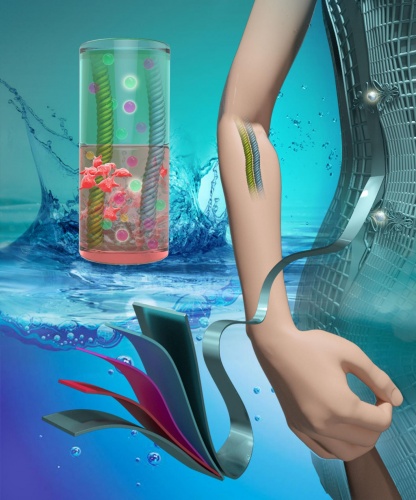
Implantable batteries that run on the type of saline used in intravenous drips or on a cell culture medium that contains compounds already found in the body could provide a safer and more easily shaped alternative to the lithium ion batteries most commonly used for miniaturised electronic devices, whether these are medical devices surgically implanted into the body or wearables for medical or other applications, according to research published by chemists at Fudan University in Shanghai.
"Current batteries like the lithium-ion ones used in medical implants generally come in rigid shapes," explained Prof Yonggang Wang of the university’s Collaborative Innovation Centre of Chemistry for Energy Materials, co-senior author on the paper in the journal Chem.
"Additionally, most of the reported flexible batteries are based on flammable organic or corrosive electrolytes, which suffer from safety hazards and poor biocompatibility for wearable devices, let alone implantable ones."
The rigidity of these batteries is generally caused by the addition of protective materials to prevent leakage of electrolytes, Wang’s team explains. Replacing these potentially hazardous materials with biocompatible fluids allows sodium-ion batteries to be made, which are slimmer and more flexible than lithium ion versions. The team tested two biocompatible electrolytes: simple saline, of the same types used in intravenous treatments as a solvent for active drug ingredients, and a cell-culture solution that contains amino acids, sugars and vitamins, designed to mimic the fluid that surrounds living cells in the body. They also tested sodium sulphite, which is non-biocompatible but stable and inert, as an electrolyte for batteries for external wearable devices.
The team designed two types of flexible battery for use with these electrolytes: a two-dimensional version composed of electrode films applied to a steel mesh, and a one-dimensional structure with electrode material nanoparticles attached to a carbon nanotube backbone. In both cases the battery cathode was made from Na0.44MnO2 and the anode from NaTi2(PO4)3@C. With sodium sulphite as the electrolyte, these batteries displayed higher charge-holding ability (indicating how long they would supply power) and power output for their size than lithium ion batteries. For the biocompatible electrolytes, the charge-holding value was slightly lower, but this could be because they had lower sodium ion concentrations. Performance was not affected by bending the batteries.
An unexpected result was that the nanofibre structures can accelerate the conversion of dissolved oxygen into hydroxide ions. This can harm battery effectiveness, but might itself have applications in cancer treatment, as tumours can be shrunk by depriving them of their oxygen supply. "We can implant these fibre-shaped electrodes into the human body to consume essential oxygen, especially for areas that are difficult for injectable drugs to reach," said Wang.
"Deoxygenation might even wipe out cancerous cells or pathogenic bacteria since they are very sensitive to changes in living environment pH. Of course, this is hypothetical right now, but we hope to investigate further with biologists and medical scientists."




Glasgow trial explores AR cues for autonomous road safety
They've ploughed into a few vulnerable road users in the past. Making that less likely will make it spectacularly easy to stop the traffic for...